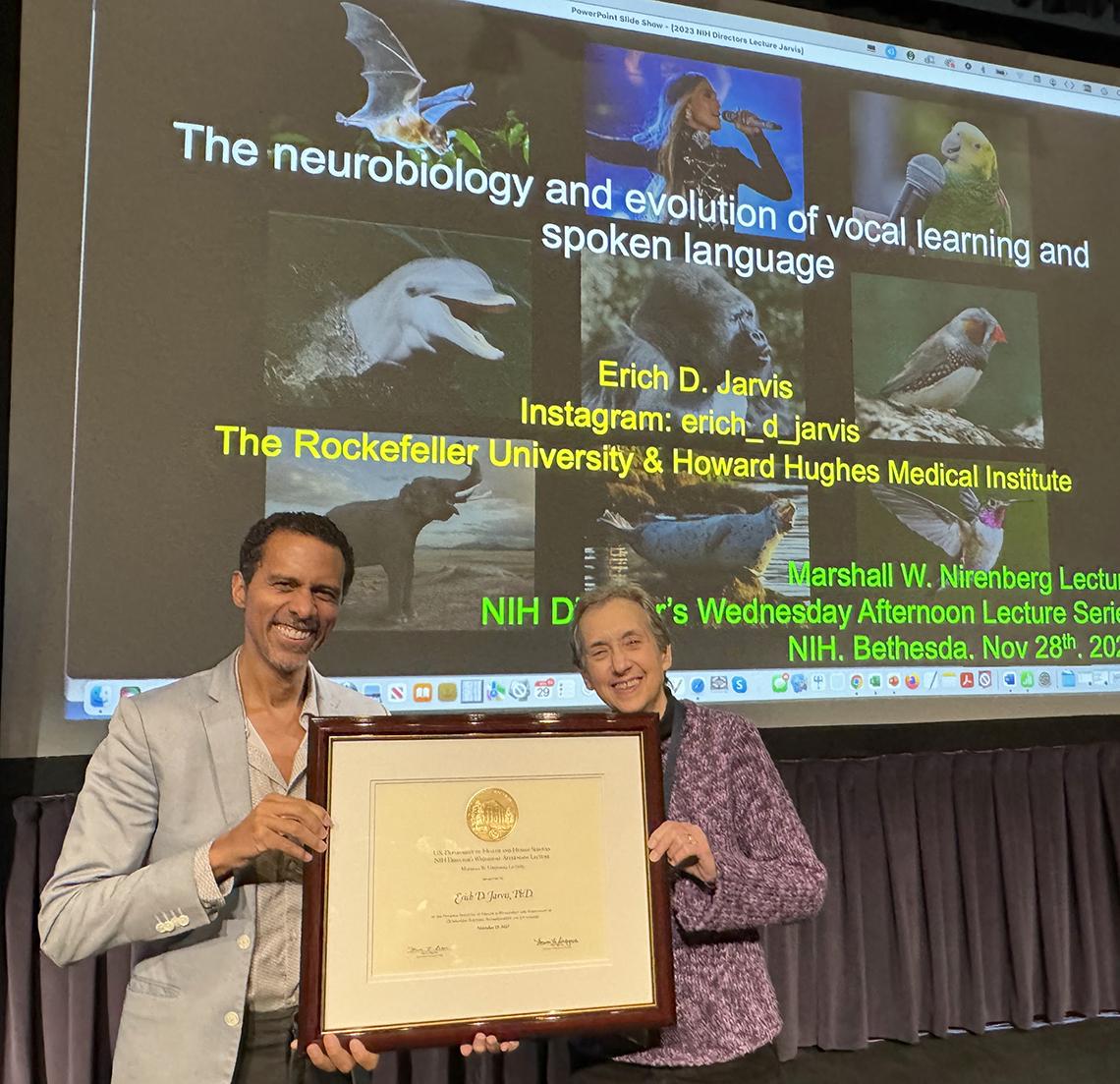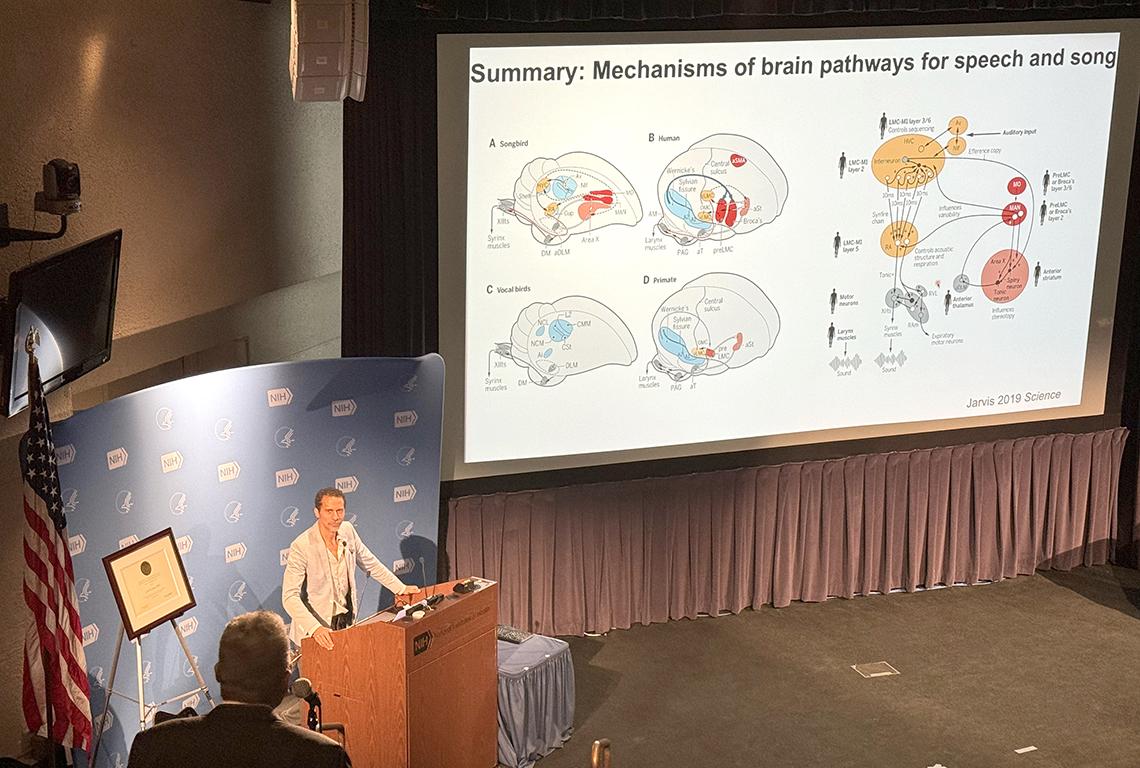Speak, Tweet and Repeat?
Songbirds Begin to Reveal Mysteries of Spoken Language

Photo: Paule Joseph
Humans, parrots, songbirds and hummingbirds share an unusual ability: they are capable of vocal production learning. That is, they can hear and repeat new sounds even if they weren’t born making them, said Dr. Erich Jarvis during the recent Marshall W. Nirenberg Lecture in Lipsett Amphitheater.
Such learning is rare, said Jarvis, professor in the Laboratory of Neurogenetics of Language at Rockefeller University and investigator at Howard Hughes Medical Institute. Parrots, songbirds, hummingbirds and humans, dolphins, whales, bats, elephants and seals are the only vocal learners in nature. When one of these species hears something new, they can imitate, produce and “pass on those vocal repertoires culturally, from one generation to the next,” he noted.
Vocal learning is just one component of spoken language. Some other components, like auditory learning, are more common in the animal kingdom. A pet dog, for instance, can understand human commands like sit, stay or roll over, but cannot vocally reply in kind.
“A dog can understand those human words, but can’t respond, ‘ok, you got it,’” Jarvis explained. In response, a dog might bark, an innate behavior. They can learn to bark in different contexts, such as wanting food or attention. This is called vocal usage learning.

Humans and parrots are the most advanced vocal production learners. A pet parrot can learn to produce over 400 words and combine them into unique sentences. In comparison, one of our closest relatives, a gorilla, can’t even get out one word, even though some gorillas have a vocabulary of understanding 7,000 words.
“That raises the question: why can’t we get our closest relatives to say something as simple as ‘apple,’ when parrots can tell you the variety of an apple, like golden delicious or Macintosh,” he said.
Following up on the 1970s work of his former Ph.D. adviser Dr. Fernando Nottebohm, Jarvis completed the identification of the brain pathways for vocal learning in canaries in the 1990s. Experiments showed that when a bird sings a learned song, it activates increased expression of genes in parts of the brain associated with vocal learning. The longer the bird sings, the stronger the gene expression becomes.
Further research revealed every species capable of vocal learning showed similar brain pathways—one for learning and one for production.
What’s remarkable is that songbirds, parrots and hummingbirds seem to have independently evolved, Jarvis observed. Each species has similar—but not identical—brain circuitry in seven brain regions.
In 2014, Jarvis co-led a consortium that sequenced the genomes of 48 bird species representing nearly all bird orders. The new evolutionary tree revealed that parrots, songbirds and hummingbirds are distantly related, suggesting that each species independently gained the vocal learning ability.
“If you would argue a common origin of these vocal learning circuits in birds, you have to go back to the time of mass extinction of dinosaurs,” he said.
The size of an animal’s brain does not determine whether it is capable of vocal learning. The brains of 3,000 zebra finches can fit inside one human brain. Yet, these birds can imitate sounds, while dogs cannot.

Photo: TAGIR FASKHUTDINOV/SHUTTERSTOCK
During experiments where birds not only sang, but moved around in a coordinated way, he noticed that regions responsible for song learning were next to regions responsible for movement.
“It seems like vocal learning circuits are embedded within this motor learning circuit,” he explained.
Around the same time, Jarvis’s colleagues studied what happened inside a person’s brain when they were taught a new dancing sequence. MRI scans revealed that the most active brain regions were adjacent to the parts of the brain that controlled speech. Another study showed that only vocal learning species can also dance to the beat in music.
Jarvis proposed that the brain areas targeted for vocal learning evolved as a specialization of a pre-existing motor pathway that controls movement. He calls it the motor theory of vocal learning origin.
All vertebrates have regions in the brain that are responsible for processing complex sounds, he said. It’s why a dog can understand spoken human commands. Additionally, they all have motor learning circuits for learning how to move, such as flying or walking, and another pathway for producing that movement. To explain these findings, he proposed that these circuits are replicated multiple times “to get hooked up to different muscle groups to control different body parts.”
In vocal learning species, “it’s replicated one more time through some genetic mutation,” Jarvis suggested. “This new replicated circuit takes over the brain stem circuit for vocal behavior to get an emergent vocal learning circuit.”
This circuit makes fine motor control in the larynx, also known as the voice box, possible. It allows for the production of imitated speech. “I call this brain evolution by brain pathway duplication,” he said.
More recently, a postdoctoral researcher in Jarvis’s lab found that songbirds that displayed more complex vocal learning had larger brains and were better at solving problems.
“There seems to be a correlation between vocal-learning ability, problem solving and the ability to learn how to dance,” he said. More research must be conducted to determine why this is the case.
His lab is also studying the genes associated with song and spoken language. There are hundreds of genes in speech and song-learning circuits that have evolved similar specialized expression levels in birds and humans.
Since 2017, Jarvis has been chair of the Vertebrate Genomes Project, an ambitious effort to sequence the genomes of 70,000 vertebrate species. Understanding the DNA sequence between all vertebrates will enable study of how genes have contributed to their evolution and survival.

Photo: Paule Joseph
The project first evaluated multiple genome sequencing and assembly approaches extensively of a hummingbird species. Having higher-quality genomes will allow the lab to make important observations about what genes are associated with speech deficits or disorders.
Even though humans and songbirds developed these circuits independently, the brain pathways for speech in species 300 million years removed from humans can reveal insights about what genes are involved in certain brain regions.
“Just because it’s convergent doesn’t mean it’s not relevant,” he concluded.
Established in 2011, the Nirenberg lecture honors its namesake for his work to decipher the genetic code, which resulted in his receiving the 1968 Nobel Prize in Physiology or Medicine.
